The snow on the ground may be at least a month old in Anchorage, but for many, December seems to mark the official start of the ski season. Whatever your preferred way to get on the snow – nordic, backcountry, or downhill laps at Alyeska – the first day on skis of the year can feel like a shock to the system. Ok, maybe mostly a shock to the quads! All that running and hiking all summer should have left you well-prepared, right? If only it were that simple…
Skiing requires a few specific strength skills that differ from how we use our bodies over the summer months. Luckily, these skills can be trained in the gym to prepare you for the snowy months ahead and most importantly, reduce your risk of getting injured and cutting your season short.
1. Balance
Whether you're gliding on a pair of skinny nordic skis or carving turns downhill, skiing is a sport that demands balance. Your core, hips, and ankles play a critical role in maintaining stability on your skis.
● Single-leg exercises: Incorporate moves like single-leg deadlifts, Bulgarian split squats, or step-ups to challenge your balance while building strength. Start with body weight and gradually add weight over time.
● Balance tools: Practice exercises on a Bosu ball or balance disc to simulate the dynamic stability required for skiing.
● Yoga or Pilates: These practices can improve your overall proprioception and core stability, which can be make you a stronger and more stable skier.
2. Strength
It’s no surprise that the burn in your quads and glutes is often the first thing you feel after a few minutes on the slopes. Building ski-specific strength will not only help you enjoy longer days on the snow but also reduce the risk of injury.
● Leg-focused exercises: Squats, lunges, and deadlifts are classics for a reason. Focus on both bilateral and unilateral leg strength.
● Explosive power: Plyometric moves like jump squats, box jumps, and lateral bounds can mimic the quick, powerful motions required for skiing.
● Core stability: Add planks, side planks, and rotational core exercises like Russian twists or cable woodchoppers to build the strength needed to handle turns and recover from off-balance moments.
3. Cardio
A strong aerobic base is essential for maintaining endurance on your skis. Even if Nordic skiing isn’t your think and you prefer to let gravity do most of the work, you might be surprised how much your aerobic fitness can support your skiing. Better endurance means you can stay out for more laps! Don’t neglect incorporating cardio into your week – both interval and easy training through running, biking, or whatever your preferred activity is!
By incorporating some of these tips into your next day at the gym, you’ll not only feel stronger on skis but also enjoy a safer and more successful start to Alaska’s ski season. Happy skiing!


